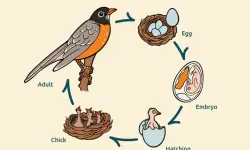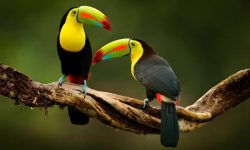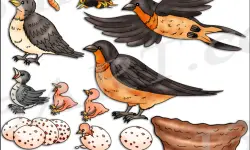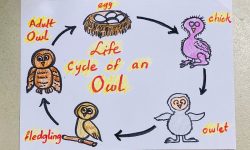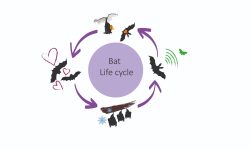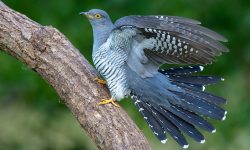California’s diverse landscapes—ranging from lush wetlands and winding rivers to coastal estuaries and seasonal lakes—offer essential stopovers and breeding grounds for millions of ducks each year. As part of the Pacific Flyway, the Golden State hosts a spectacular array of waterfowl during both migration and wintering seasons, making it a paradise for birdwatchers and conservationists alike. Among the wide variety of ducks found here, twelve species stand out not only for their vivid plumage and fascinating behavior but also for the vital ecological roles they play in aquatic ecosystems. From the iconic Mallard to the elegant Canvasback, each duck tells a unique story of adaptation, movement, and survival in California’s ever-shifting natural environments.
1. Mallard (Anas platyrhynchos)

Physical Characteristics and Sexual Dimorphism
Mallards are highly recognizable and exhibit strong sexual dimorphism. Males have a glossy green head, yellow bill, white neck ring, and chestnut-brown chest, making them striking during breeding season. Females are mottled brown with an orange bill marked by dark patches, helping them blend into nesting habitats.
Both sexes share a blue-violet speculum bordered in white—useful for species recognition and flock coordination. After breeding, males enter eclipse plumage, temporarily resembling females to reduce predation while molting.
Habitat and Range in California
Mallards are year-round residents across California. They thrive in diverse freshwater habitats, from urban ponds and agricultural ditches to marshes and riverbanks. The Central Valley becomes especially important in winter, hosting thousands of migrants from northern regions.
Their adaptability allows them to occupy both wild wetlands and human-dominated landscapes, making them one of California’s most widespread ducks.
Feeding Habits
Mallards are dabbling ducks, feeding by tipping forward in shallow water. Their diet is omnivorous, including:
-
Aquatic plants and seeds
-
Insects and small invertebrates
-
Grains in agricultural fields
In cities, they often consume human-provided food, though this is nutritionally poor. Mallards adjust their diet seasonally, increasing protein intake during breeding. Their foraging also impacts wetland ecosystems by stirring sediments and influencing plant growth.
2. Northern Pintail (Anas acuta)
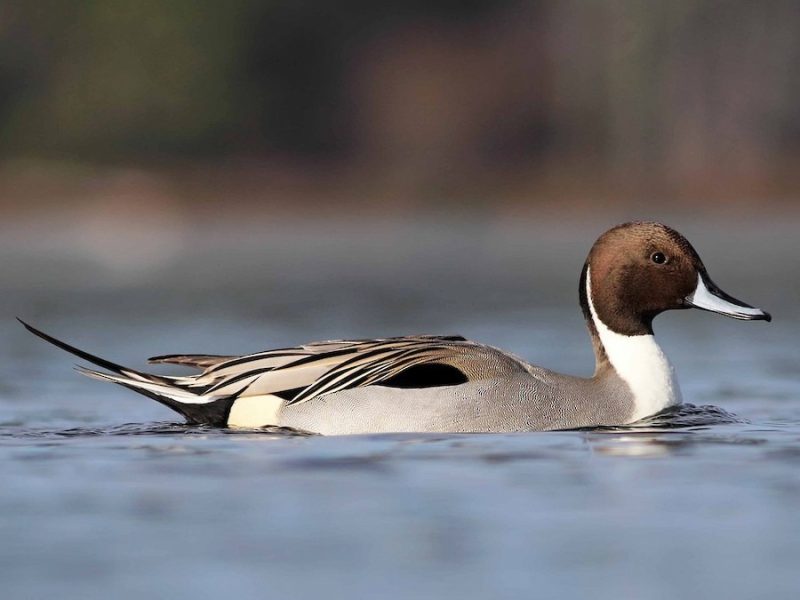
Elegant Appearance and Streamlined Build
Northern Pintails are among the most elegant of dabbling ducks, noted for their slender necks, long central tail feathers, and aerodynamic body shape. Males have a chocolate-brown head, white stripe running up the neck, and smooth gray flanks, projecting a sleek profile in both flight and water. Females are more subdued in light brown tones, with a long, pointed tail that still hints at the species’ signature silhouette.
Their narrow wings and tapered bodies make them exceptionally graceful in flight, often flying in swift, darting formations during migration or while flushed from wetlands.
Seasonal Visitors in California
Northern Pintails are abundant winter migrants in California, especially within the Sacramento and San Joaquin Valleys. Arriving from breeding grounds in Alaska and Canada, they settle in flooded agricultural fields, seasonal marshes, and refuge wetlands, where they gather in large flocks.
They show a strong preference for shallow, open wetlands with sparse vegetation, particularly post-harvest rice fields, where leftover grain provides a critical food source. Their numbers in California often peak between November and February.
Courtship Displays and Breeding
While not major breeders in California, courtship displays become visible in late winter before spring migration. Males perform elegant rituals, including:
-
Head-up, tail-up postures
-
Whistling calls combined with short swims or chases
These displays help females select the fittest partners before returning to northern breeding grounds. Breeding primarily occurs in the prairie pothole region and tundra wetlands, where females build ground nests in tall grass or low shrubs.
3. American Wigeon (Mareca americana)
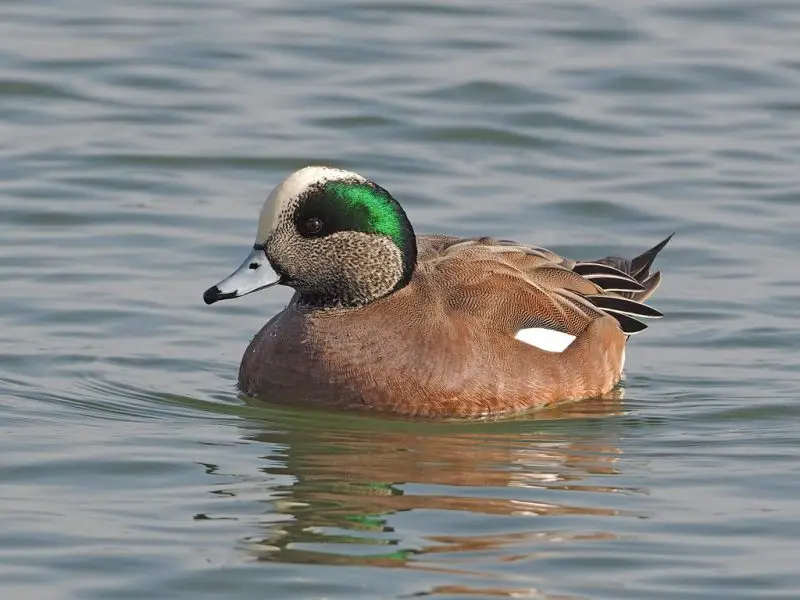
Compact Build and Distinctive Coloring
The American Wigeon is a medium-sized dabbling duck with a compact, rounded body and short bill. Males are distinctive, showing a pale cream or white crown, a metallic green patch behind the eye, and rosy-pink flanks, giving them a striking appearance in mixed flocks. Females are more muted in gray-brown tones, with a softly speckled head and a pale belly.
Their small, bluish-gray bill with a black tip helps distinguish them from other dabblers at close range.
Adaptability in Feeding
American Wigeons are unusually terrestrial for dabbling ducks, often seen grazing on grasses in upland fields or near the edges of wetlands. This behavior sets them apart from species that feed exclusively in water.
They are also known as “baldpates” due to the male’s pale head. Clever foragers, Wigeons often snatch aquatic vegetation from diving birds like coots as they surface, avoiding the need to dive or submerge themselves.
Their diet includes:
-
Grasses and sedges
-
Algae and aquatic plants
-
Seeds and crop residues, especially in flooded fields
Importance in California Wetlands
American Wigeons are abundant winter residents in California, favoring managed wetlands, sloughs, reservoirs, and grassy margins of marshes. They are especially common in wildlife refuges and the Central Valley, where large flocks gather from fall through early spring.
By feeding heavily on vegetation, Wigeons help regulate plant growth in wetland ecosystems, contributing to the balance of emergent and submerged plant communities. Their presence also reflects the health and productivity of seasonal wetlands.
4. Gadwall (Mareca strepera)
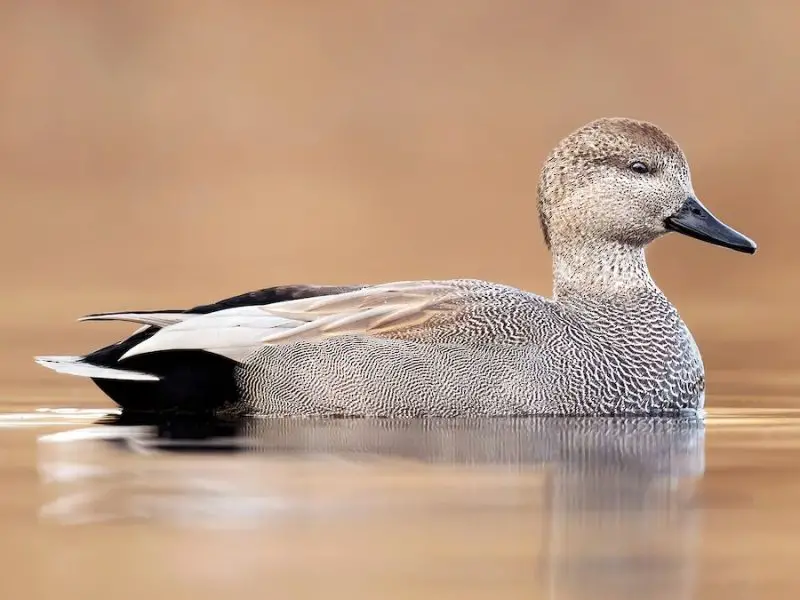
Subtle Beauty and Field Identification
Though often overlooked, Gadwalls display a refined beauty upon closer look. Males are patterned with scalloped gray, chestnut highlights, and a distinct black rump, which is often the key to field identification. Their appearance lacks the flashy colors of Mallards but rewards the attentive observer.
Females resemble female Mallards in plumage but are more uniformly mottled brown and have a plain, dark bill rather than orange. Both sexes show a white speculum—a useful field mark visible in flight or when preening.
Efficient Foraging Behavior
Gadwalls are dabbling ducks, but they often feed in slightly deeper water than typical dabblers. They readily consume submerged aquatic vegetation, especially:
-
Pondweed
-
Wigeon grass
-
Algae and soft aquatic stems
They also forage on land, grazing in wet meadows and flooded fields. Unlike some dabblers, Gadwalls are quiet and deliberate feeders, often mixing with other species but keeping a low profile.
Their feeding style supports healthy wetland vegetation dynamics, especially in shallow, plant-rich areas.
Conservation Status in California
Gadwalls have shown stable or increasing populations, aided by wetland restoration and habitat conservation programs in the Pacific Flyway. They are one of the few dabblers that both breed and winter in California.
Key breeding areas include:
-
Northeastern California, particularly the Klamath Basin and Modoc Plateau
-
Managed wetlands and rice fields during the winter months
Their strong presence in restored habitats makes them a conservation success story among North American waterfowl.
5. Green-winged Teal (Anas crecca)
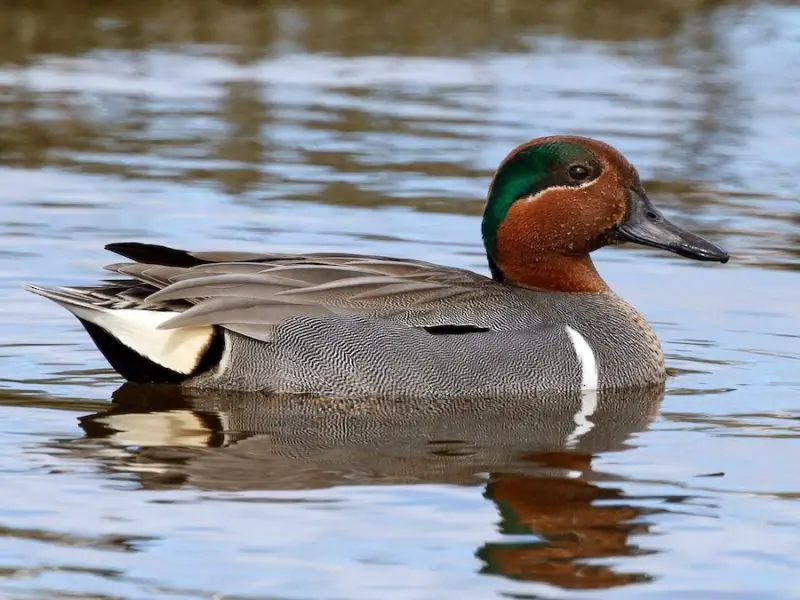
The Smallest Dabbling Duck
Green-winged Teals are the smallest dabbling ducks in North America, with short necks, compact bodies, and rapid wingbeats. Males are distinctive with a chestnut head, a bold emerald-green eye patch sweeping back to the nape, and cream-colored vertical stripe on the flanks.
Females are finely mottled in warm brown tones, similar to other female dabblers but smaller and more delicately built. In flight, both sexes reveal a bright green speculum, edged in black and buff, which gives the species its name.
Migratory Patterns in California
Green-winged Teals are abundant winter visitors throughout California, arriving in large numbers from Alaska and Canada. They concentrate in shallow seasonal wetlands, flooded rice fields, and mudflats, where their small size allows access to food in thin water layers.
Flocks can number in the thousands during migration, especially during fall (September–November) and early spring (February–March). They are often among the first ducks to arrive in autumn and first to leave in spring, making them useful seasonal indicators.
Feeding and Behavior
Green-winged Teals feed mostly by dabbling and picking at the surface, rarely tipping like larger dabblers. Their diet includes:
-
Seeds from sedges, grasses, and smartweed
-
Small aquatic insects and crustaceans
-
Algae and detritus
Their small size and quick movements make them highly efficient in very shallow wetlands that other ducks may avoid. They’re often skittish and fast to flush, moving in tight, agile flocks when disturbed.
6. Cinnamon Teal (Spatula cyanoptera)
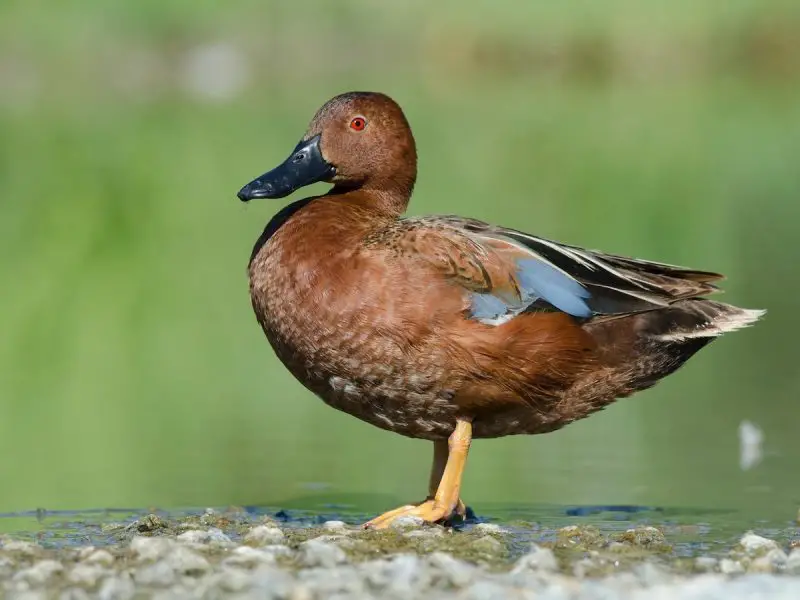
Vivid Plumage and Local Breeder
The Cinnamon Teal is among the most strikingly colored ducks in North America. Males are unmistakable with deep cinnamon-red plumage, bright red eyes, and a slate-blue shoulder patch visible in flight or when at rest. Their vibrant coloration peaks during breeding season.
Females are more subdued, resembling female Blue-winged Teal but slightly larger, with a warmer brown overall tone and a broader bill. Both sexes have a broad, spatula-shaped bill, adapted for filter feeding.
Breeding Distribution in California
Cinnamon Teal are local breeders across California, favoring shallow freshwater marshes, ponds, and irrigation canals. They are especially common in the Central Valley, Klamath Basin, and Intermountain regions.
They are among the earliest nesting ducks, with pairs forming as early as February, and nesting by March. Nests are usually built close to the water in dense emergent vegetation.
Feeding and Behavior
Cinnamon Teal are filter-feeders, using their broad, flattened bills to strain food from shallow water. Their diet includes:
-
Seeds from aquatic plants
-
Small aquatic insects
-
Algae and soft vegetation
Outside the breeding season, they often join mixed flocks with other small dabblers like Green-winged Teal and American Wigeons, especially in post-harvest wetlands. Though generally shy, they can be observed feeding calmly in quiet, vegetated ponds.
7. Northern Shoveler (Spatula clypeata)

Unique Spatulate Bill
The Northern Shoveler is easy to identify by its oversized, spoon-shaped bill, which is broader at the tip than at the base. This unique feature gives the bird a distinct silhouette in profile.
Males are vividly marked with a glossy green head, white chest, and chestnut-colored flanks, while their bold plumage contrasts with the striking orange legs.
Females are more subdued in mottled brown, but also possess the large, orange spatulate bill, giving them a recognizable shape even at a distance.
Specialized Feeding Mechanism
Northern Shovelers are highly specialized filter-feeders. Their large bills are lined with lamellae, fine comb-like structures that help them strain plankton, seeds, and small invertebrates from the water.
They are known for their unique circular feeding behavior, where groups spin in tight formations to stir up sediment and concentrate food—a rare example of cooperative foraging among dabbling ducks.
Their diet includes:
-
Zooplankton and aquatic insects
-
Seeds of wetland plants
-
Tiny crustaceans and organic particles in nutrient-rich water
Role in California Wetlands
Northern Shovelers are among the most abundant wintering ducks in California, especially in seasonal wetlands, refuges, and flooded fields across the Central Valley and Imperial Valley.
Their presence is often associated with healthy wetland ecosystems, as they rely on rich aquatic invertebrate communities. Monitoring Shoveler populations can help conservationists gauge the productivity and quality of shallow wetland habitats during the non-breeding season.
8. Blue-winged Teal (Spatula discors)

Compact Frame and Distinctive Plumage
The Blue-winged Teal is a small, fast-flying dabbling duck, easily recognized in flight by its pale blue forewing patch, visible in both sexes. Males in breeding plumage have a slate-gray head, a bold white crescent in front of the eye, and a spotted brown body.
Females are mottled brown and can resemble Cinnamon Teal females but are generally smaller, with a less robust bill and a subtle, paler facial pattern. Outside the breeding season, males resemble females but retain the blue wing patch and finer structure.
Seasonal Presence in California
Blue-winged Teal are less common than other teal species in California but are regular migrants, especially during spring and fall. They favor shallow wetlands, rice fields, and ephemeral pools, where they stop to rest and feed.
While a few may breed in northeastern California or the Central Valley, most individuals seen in the state are passing through to or from breeding areas in the northern Great Plains and wintering grounds in Mexico and Central America.
Feeding and Behavior
Blue-winged Teal are dabblers, feeding in very shallow water or along muddy edges. Their diet consists mainly of:
-
Seeds from sedges, grasses, and smartweed
-
Small aquatic invertebrates
-
Algae and aquatic detritus
They are often seen in small, tightly-knit flocks, flying low over marshes. During migration, they are among the earliest species to depart in fall and latest to return in spring, adapting quickly to seasonal shifts.
Though less abundant in California than Green-winged or Cinnamon Teal, their presence adds to the biodiversity of seasonal wetlands, especially during migration peaks.
9. Mottled Duck (Anas fulvigula)
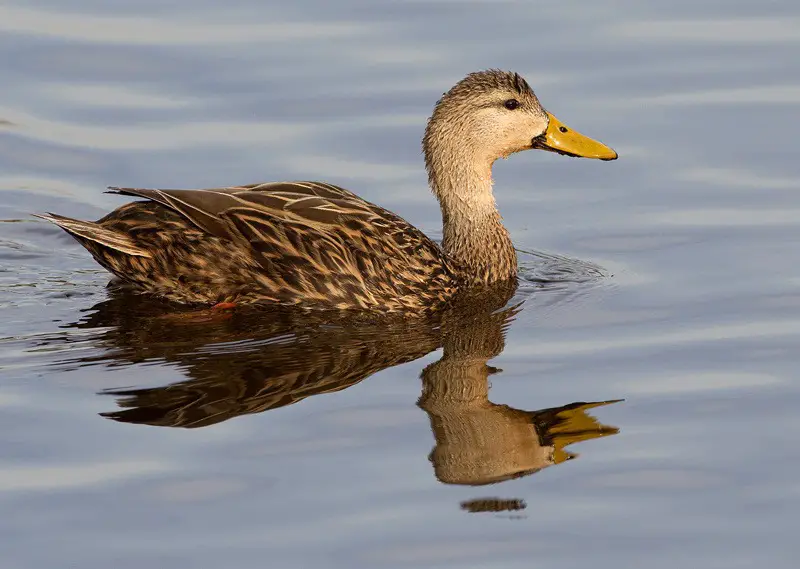
Subtle Appearance and Regional Identity
The Mottled Duck is a medium-sized dabbling duck, closely related to the Mallard but more uniform in coloration. Both sexes have warm brown bodies, dark mottling, and a plain buffy face with a distinct dark eyeline. Unlike Mallards, they lack a white neck ring and show no iridescent head coloration.
Males and females appear similar, though males have brighter yellow bills, while females tend toward orange-brown bills. The speculum is iridescent green-blue without white borders, helping distinguish them from Mallards in flight.
Rare Occurrence in California
Mottled Ducks are native to the southeastern U.S., particularly in Florida, Texas, and parts of the Gulf Coast. Their presence in California is extremely rare, limited to accidental vagrants likely displaced by weather events or disoriented during migration.
Sightings in California are exceptional and sporadic, usually involving single birds observed in freshwater marshes or with Mallard flocks. They are not regular migrants or residents in the state.
Conservation and Identification Challenges
Mottled Ducks face significant conservation concern in their core range due to:
-
Hybridization with feral Mallards, which threatens genetic purity
-
Loss of coastal marsh habitat, especially in Louisiana and Texas
In California, the rarity of this species means careful identification is crucial, especially due to confusion with female Mallards or Mexican Ducks (Anas diazi). Birders rely on subtle field marks like bill color, lack of white tail borders, and overall even plumage tone.
10. Wood Duck (Aix sponsa)
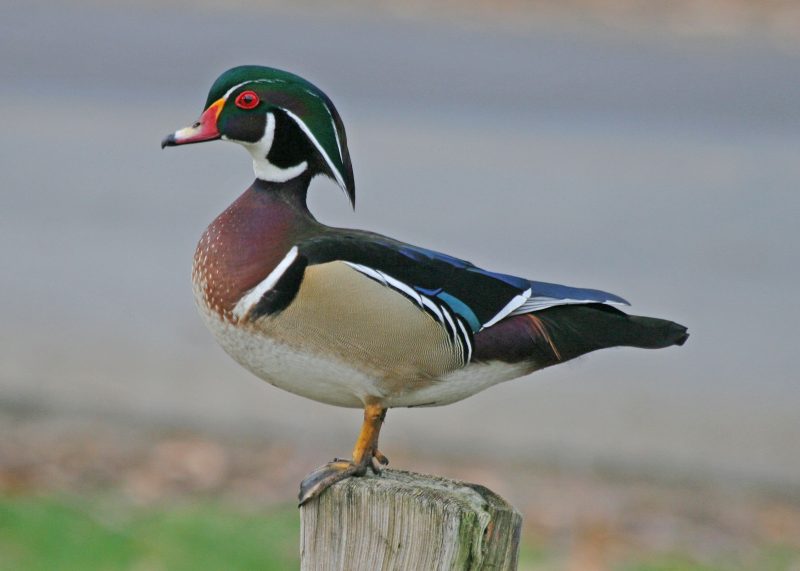
Dazzling Plumage and Crest
The Wood Duck is one of the most ornate waterfowl in North America. Males are striking, with a glossy green head, bold white facial stripes, red eyes, and iridescent chestnut and bronze flanks. Their elegant crest gives the head a boxy shape.
Females are more understated but graceful, with a gray-brown body, white teardrop eye ring, and a slightly crested head. Both sexes have broad, square tails and strong claws for perching—unusual among ducks.
Resident Breeder in California
Wood Ducks are year-round residents in parts of California, especially in riparian woodlands, slow-moving rivers, ponds, and swamps with ample tree cover. They are most common in the Central Valley, Sierra Nevada foothills, and coastal ranges.
They are cavity nesters, relying on tree hollows or nest boxes placed near water. Nesting begins early—as soon as February in warmer areas.
Thanks to widespread nest box programs, Wood Duck populations have rebounded from near collapse in the early 20th century due to overhunting and deforestation.
Feeding and Behavior
Wood Ducks forage in shallow water, flooded forests, and on land. Their diet includes:
-
Acorns and seeds
-
Aquatic insects and snails
-
Berries and other forest fruits
They are agile and often perch on tree branches, making them one of the few North American ducks adapted to life both on water and in trees. In flight, they are swift and maneuverable, weaving easily through dense canopy.
11. Canvasback (Aythya valisineria)
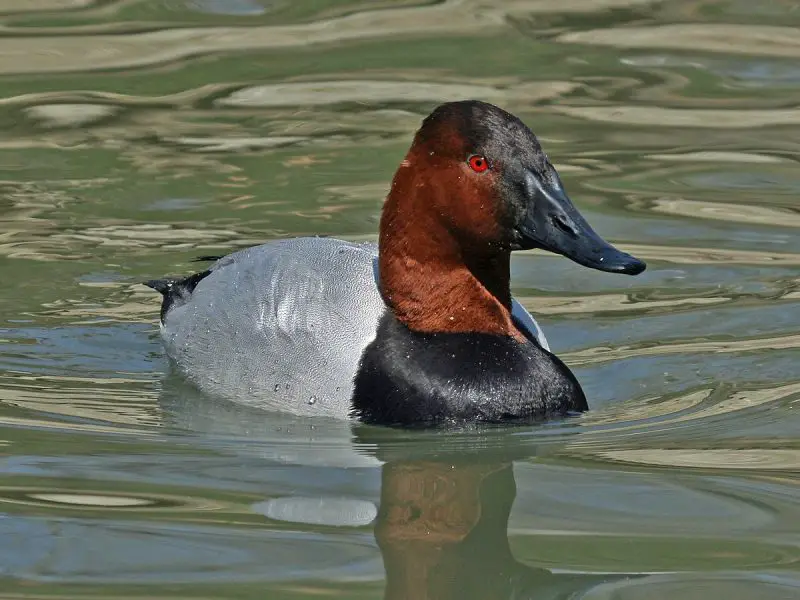
Sleek Profile and Distinctive Shape
The Canvasback is a large, elegant diving duck known for its sloping forehead, long black bill, and distinctive silhouette. Males have a rich chestnut-red head, black chest, and pale gray-white body that appears almost canvas-colored—hence the name.
Females are similar in structure but show soft tan-brown plumage with a paler face and eye line. Both sexes exhibit red eyes, especially noticeable in males during the breeding season.
Their long, tapered head and straight bill profile distinguish them from similar species like the Redhead.
Wintering Populations in California
Canvasbacks are regular winter visitors to California’s inland freshwater lakes, wetlands, and estuarine bays. The Central Valley, San Francisco Bay, and Salton Sea are important stopover and wintering sites along the Pacific Flyway.
While rare as breeders in California, small numbers may nest in northeastern marshes near the Oregon border, particularly in extensive cattail beds.
Their populations peak between November and March, often seen in mixed flocks with Redheads, Scaup, and Ruddy Ducks.
Feeding and Diving Behavior
Canvasbacks are specialized diving ducks, foraging by swimming underwater in deeper lakes and marshes. Their diet focuses on:
-
Submerged aquatic vegetation, especially wild celery (Vallisneria americana)—a favorite in their core range
-
Rhizomes, tubers, and seeds
-
Aquatic insects and mollusks, particularly during breeding
They dive with powerful legs and webbed feet, often staying submerged for 10–20 seconds. Because of their specialized diet and habitat needs, Canvasbacks are considered indicators of wetland health.
12. Redhead (Aythya americana)
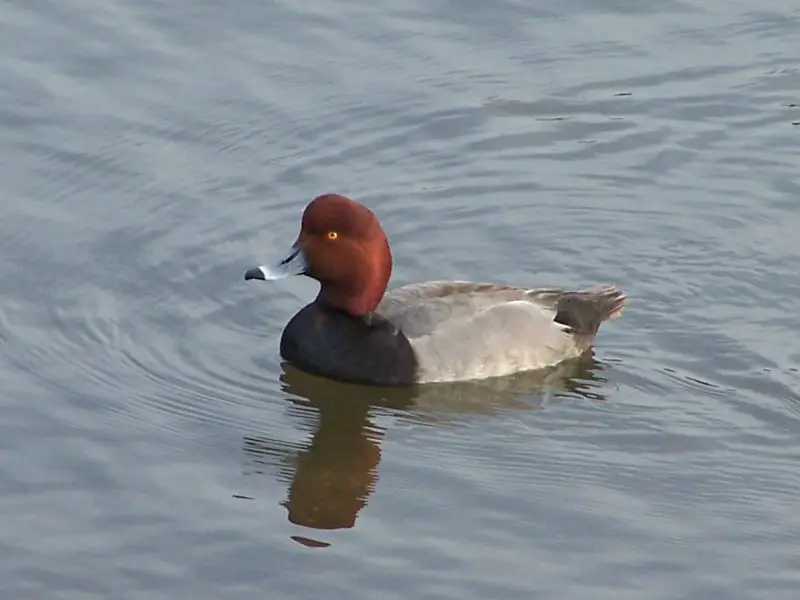
Rounded Profile and Bold Colors
The Redhead is a medium-sized diving duck with a rounded head and blue-gray bill tipped in black. Males are eye-catching with a coppery red head, black chest, and pale gray back and flanks. Their bright yellow eyes add to the striking appearance.
Females are uniformly warm brown, with a paler face and slightly darker crown. Their soft, rounded shape and bill pattern help distinguish them from similar species like female Canvasbacks and Ring-necked Ducks.
Their compact shape and short neck give them a stockier appearance than the sleeker Canvasback.
Widespread in California Winters
Redheads are common wintering ducks across California, especially in the Central Valley, Salton Sea, and coastal lagoons. They arrive in late fall and stay through early spring, often forming dense flocks on lakes, reservoirs, and managed wetlands.
Although they rarely breed in California, a few may nest in northeastern marshes during wet years.
Redheads are often seen with Canvasbacks, Scaup, and other diving ducks, but are more tolerant of slightly shallower water.
Feeding and Social Behavior
Redheads are omnivorous diving ducks, with a diet including:
-
Seeds and tubers of aquatic plants
-
Algae and pondweeds
-
Aquatic insects, snails, and small crustaceans
They are less specialized than Canvasbacks and may also dabble at the surface when food is accessible. In winter, they feed heavily in flooded grain fields and marshes.
Redheads are gregarious, often forming large, compact rafts with synchronized movements on open water. Their social nature and broad diet make them highly adaptable among North American diving ducks.
Conclusion
From the iconic Mallard to the specialized Northern Shoveler, California’s duck population is both diverse and ecologically important. These seven species represent the broader richness of the state’s birdlife, each with its own unique adaptations and roles in the wetland environment. As pressures from habitat loss and climate change continue to mount, conserving these ducks and their habitats remains essential. For birders, hunters, ecologists, and nature lovers alike, understanding these species is the first step in protecting them for generations to come.

